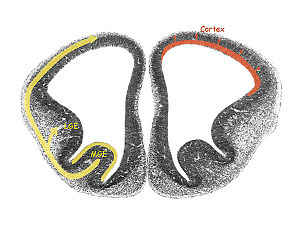
Ganglionic eminence
Encyclopedia

Neuroanatomy
Neuroanatomy is the study of the anatomy and organization of the nervous system. In contrast to animals with radial symmetry, whose nervous system consists of a distributed network of cells, animals with bilateral symmetry have segregated, defined nervous systems, and thus we can begin to speak of...
and neuroembryology, a ganglionic eminence (GE) is a transitory brain
Brain
The brain is the center of the nervous system in all vertebrate and most invertebrate animals—only a few primitive invertebrates such as sponges, jellyfish, sea squirts and starfishes do not have one. It is located in the head, usually close to primary sensory apparatus such as vision, hearing,...
structure present in the embryonic and fetal stages of brain development
Neural development
Neural development comprises the processes that generate, shape, and reshape the nervous system, from the earliest stages of embryogenesis to the final years of life. The study of neural development aims to describe the cellular basis of brain development and to address the underlying mechanisms...
. The eminences are found in the ventral part of the telencephalon
Telencephalon
The cerebrum or telencephalon, together with the diencephalon, constitutes the forebrain. The cerebrum is the most anterior region of the vertebrate central nervous system. Telencephalon refers to the embryonic structure, from which the mature cerebrum develops...
, where they form bulges in the ventricles
Ventricular system
The ventricular system is a set of structures containing cerebrospinal fluid in the brain. It is continuous with the central canal of the spinal cord.-Components:The system comprises four ventricles:* right and left lateral ventricles* third ventricle...
. These bulges develop into the basal ganglia
Basal ganglia
The basal ganglia are a group of nuclei of varied origin in the brains of vertebrates that act as a cohesive functional unit. They are situated at the base of the forebrain and are strongly connected with the cerebral cortex, thalamus and other brain areas...
. They also contribute significantly in building up the GABA
Gabâ
Gabâ or gabaa, for the people in many parts of the Philippines), is the concept of a non-human and non-divine, imminent retribution. A sort of negative karma, it is generally seen as an evil effect on a person because of their wrongdoings or transgressions...
ergic cortical
Cerebral cortex
The cerebral cortex is a sheet of neural tissue that is outermost to the cerebrum of the mammalian brain. It plays a key role in memory, attention, perceptual awareness, thought, language, and consciousness. It is constituted of up to six horizontal layers, each of which has a different...
cell
Cell (biology)
The cell is the basic structural and functional unit of all known living organisms. It is the smallest unit of life that is classified as a living thing, and is often called the building block of life. The Alberts text discusses how the "cellular building blocks" move to shape developing embryos....
population.
Categorization
Ganglionic eminences are categorized into three groups based on location:- Lateral ganglionic eminences (LGE)
- Medial ganglionic eminences (MGE)
- Caudal ganglionic eminences (CGE)
In humans
In humanHuman
Humans are the only living species in the Homo genus...
s, ganglionic eminences serve as the source of GABAergic thalamic
Thalamus
The thalamus is a midline paired symmetrical structure within the brains of vertebrates, including humans. It is situated between the cerebral cortex and midbrain, both in terms of location and neurological connections...
neuron
Neuron
A neuron is an electrically excitable cell that processes and transmits information by electrical and chemical signaling. Chemical signaling occurs via synapses, specialized connections with other cells. Neurons connect to each other to form networks. Neurons are the core components of the nervous...
s, which migrate through another transient brain structure peculiar to humans, the gangliothalamic body (GTB). GEs also present an intermediate target for the axon
Axon
An axon is a long, slender projection of a nerve cell, or neuron, that conducts electrical impulses away from the neuron's cell body or soma....
s growing from the thalamus into the cortex and vice versa. They disappear just before birth.

